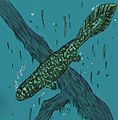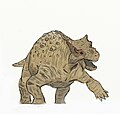Wikipedia:WikiProject Palaeontology/Paleoart review/Archive 7

This image I found on commons, and seems to be relatively accurate. Is there anything wrong with this, or is it ready for inclusion into the articles? IJReid discuss 00:14, 7 January 2015 (UTC)
- Only concern could be whether parts of it are drawn after other images, since some areas look more detailed etc. than others.... By the way, should I archive the 2014 entries, or wait till the page is longer? FunkMonk (talk) 05:33, 7 January 2015 (UTC)
- I think it could be archived, as 2014's is already longer than 2013's. I don't know about basing off other drawings. IJReid discuss 15:46, 7 January 2015 (UTC)
- Looking in the web I have not find any image really similar to the animals portrayed here, although the name of the image says "Saurosuchus Ischigualastia" but the dead animal must be some rhynchosaur.
- I'm agree with archive the 2014 entries (by the way, the Forstercooperia entry still needs to be discussed?).--Rextron (talk) 09:23, 8 January 2015 (UTC)
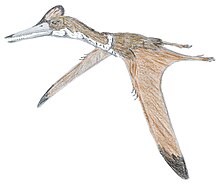
Here is a restoration of Kryptodrakon progenitor, the basalmost pterodactyloid described last year. I used the skeletal in the description as reference 1 . I'm not sure wether it should have a crest or not. Opinions? --El fosilmaníaco (talk) 22:23, 15 January 2015 (UTC)
- Looks good. I would go with no crest btw. IJReid discuss 23:51, 15 January 2015 (UTC)
- I like it too. Also, since that there is not any skull material, keep it crestless is the best option, in my opinion.--Rextron (talk) 09:35, 16 January 2015 (UTC)
- Ok, then I'll put it in the article. By the way, don't you think this little guy deserves more attention? Since it's description it has been ignored by most of the paleontological community, despite it's relevance. Poor Kryptodrakon! --El fosilmaníaco (talk) 09:23, 18 January 2015 (UTC)
- I don't agree about no crest. There are very few monofenestratan pterosaurs that are NOT known to have a crest when skull material is known. Even species that were long thought crestless have turned out to have crests whenever soft tissue is found. The exceptions are very young juveniles and in some cases females (though in other cases females simply have smaller crests). Crests are the ancestral condition and are nearly universal in pterodactyloids. Dinoguy2 (talk) 11:29, 15 February 2015 (UTC)
- Well, I was talking about social repercussion, since other taxa described last year had a lot more attention from the public. Of course I wasn't talking about the academic world ;). Returning to the crest issue, it's probable this pterosaur had a crest. However, now the original picture is not available for me, so I can't edit it. By the end of March I should have recovered it, but until then we can remove the picture, or say it's a female. Whatever you want. --El fosilmaníaco (talk) 22:23, 15 February 2015 (UTC)
- Ok, then I'll put it in the article. By the way, don't you think this little guy deserves more attention? Since it's description it has been ignored by most of the paleontological community, despite it's relevance. Poor Kryptodrakon! --El fosilmaníaco (talk) 09:23, 18 January 2015 (UTC)
- I like it too. Also, since that there is not any skull material, keep it crestless is the best option, in my opinion.--Rextron (talk) 09:35, 16 January 2015 (UTC)
Langstonia (round 2)[edit]
So, I reworked the old version, with the posture of the limbs suggested the last time in the revision, still needs adjust in the thickness of the throat and tail, but the belly is already done. The coloration is slightly different (with some more green and brown) [1]. What do you think? --Rextron (talk) 02:14, 10 February 2015 (UTC)
- Let's hear Petter Bøckman out. FunkMonk (talk) 14:50, 11 February 2015 (UTC)
- A lot better than last time! The stance makes sense now. The tail looks in proportion to the body. I'm a bit undecided about the neck, it still seems a tad deep compared to the rather flat skull.
- The colours look great and very convincing, but I preferred the earlier colours as they made it easier to see the anatomy. Petter Bøckman (talk) 20:24, 11 February 2015 (UTC)
- Well, the changes has been made: [2] I hope looks better now.--Rextron (talk) 09:32, 13 February 2015 (UTC)
- I would upload it, unless Petter Bøckman has anything else to say. IJReid discuss 04:37, 15 March 2015 (UTC)
- Looks great to me! Petter Bøckman (talk) 09:05, 18 March 2015 (UTC)
- I would upload it, unless Petter Bøckman has anything else to say. IJReid discuss 04:37, 15 March 2015 (UTC)

Hello everyone. I bring you here a restoration of Ichthyornis, since the two by Nobu Tamura appear to be obsolete. The main reference is Marsh's skeletal (the one in the article), and color is based obviously in some species of seagulls and terns. I'm not sure about the length of the lower beak. Should be there a beak or not? What do you think?--El fosilmaníaco (talk) 20:11, 13 February 2015 (UTC)
- I think that looks good. About your question, according to this paper (Hieronymus & Witmer, 2010) [3] in both Hesperornis and Ichthyornis just the very tip of the lower jaw had a cornified beak, the areas with teeth had skin.--Rextron (talk) 23:17, 13 February 2015 (UTC)
- Ichthyornis' lower jaw has teeth even at the tip, so does it mean that zone should be covered with skin or feathers and not a keratinous beak?--El fosilmaníaco (talk) 22:20, 14 February 2015 (UTC)
- I'm confused about that. The photographs and diagrams shows usually teeth in all the jaw, except in this figure of a paper (figure j): [4] that shows a small beak in the tip. --Rextron (talk) 00:56, 15 February 2015 (UTC)
- The answer basically comes down to weather or not Ichthyornis had a predentary bone. Many older sources suggest this is unique to hesperornitheans, but it has since been found in a wide variety of Jehol ornithuromorphs. Ichthyornis skull material is not exactly the greatest, but it probably did have a predentaty[5]. If it didn't, then the lower beak would have had to have been evolved in ornithuromorphs, lost at the base of Carinatae, and then almost immediately re-evolved minus the predentary in Aves. More likely, the beaked predentary simply fused with the dentary in Aves. So yes, there should probably be a very small beak at the tip of the lower jaw. Dinoguy2 (talk) 11:22, 15 February 2015 (UTC)
- Done. Now there is a little beak at the tip of the lower jaw, although is hard to see. Any other issues?--El fosilmaníaco (talk) 15:01, 15 February 2015 (UTC)
- I'm confused about that. The photographs and diagrams shows usually teeth in all the jaw, except in this figure of a paper (figure j): [4] that shows a small beak in the tip. --Rextron (talk) 00:56, 15 February 2015 (UTC)
- Ichthyornis' lower jaw has teeth even at the tip, so does it mean that zone should be covered with skin or feathers and not a keratinous beak?--El fosilmaníaco (talk) 22:20, 14 February 2015 (UTC)
Purussaurus' size[edit]

Since that the size of Purussaurus brasiliensis has been updated in the latest article about it ([6]), the scale diagram must be updated... I don't know if the size of the another species show there needs modifications.--Rextron (talk) 21:49, 26 February 2015 (UTC)
- Will have to ping Dinoguy2, since he made it,and can update the source file... FunkMonk (talk) 01:46, 27 February 2015 (UTC)
- On this note, could the Spinosaurus here[7] be updated as well, Dinoguy2? FunkMonk (talk) 16:43, 2 March 2015 (UTC)
- This pic is by Smokeybjb actually, but i'll see if I still have the source file to update the spinosaurids. Dinoguy2 (talk) 18:43, 3 April 2015 (UTC)
- That paper makes a big mistake on its estimates, using maximum skull length as DCL, on top of other issues resulting from using equations based on diminutive (<1m), much shorter snouted living relative. Mike.BRZ (talk) 16:53, 12 March 2016 (UTC)
- On this note, could the Spinosaurus here[7] be updated as well, Dinoguy2? FunkMonk (talk) 16:43, 2 March 2015 (UTC)
Some generic azhdarchid[8], that could be used in any article about a genus known from scraps. Any issues, and what should the animal be? FunkMonk (talk) 12:05, 8 March 2015 (UTC)
- No issues, but the crest might be more appropriate if it was gone or similar to the one on your Phosphatodraco. Could it be for Alanqa, known only from a jaw that would fit? IJReid discuss 00:34, 9 March 2015 (UTC)
- I also say it would be nice to put a Alanqa , but also would be nice Azhdarcho . Levi bernardo (talk) 03:16, 9 March 2015 (UTC)
- I'm not sure about the length of the wings, is not suppose that the wings of azhdarchids have a relatively short fourth finger? (like this: [9]) --Rextron (talk) 00:29, 10 March 2015 (UTC)
- Yeah, thought the wings were a bit too long. As for the crest, as far as I know, there is pretty much no evidence for azhdarchid crest shape (apart form this Quetzalcoatlus scrap[10])? It has become fashonable in recent years to give them thalassodromid-like crests, I guess due to Mark Witton's restorations. Anyhow, i should probably make it less "fin"-like. FunkMonk (talk) 17:37, 2 April 2015 (UTC)
- I'd question the wisdom of using generic reconstructions for scrappy species, especially after things like Spinosaurus and Deinocheirus turn up. Wouldn't it be better to use a generic silhouette or something, and just use the same one for all the scrappy species in a family? Creating detailed life restorations for each species and making them look different from each other is a little misleading since they're by their nature entirely inferred. Dinoguy2 (talk) 18:37, 3 April 2015 (UTC)
- Ah, yeah, I see the point of not making them so distinct as to be misleading. But I think a generic reconstruction is just as good as a silhouette, nicer to look at anyway... The historical tradition seems to have been to make life restorations for even the scrappiest species, even today.[11] FunkMonk (talk) 19:29, 3 April 2015 (UTC)
- Yeah, I know what you mean, but the more I think about it, the more I think we really should not be restoring anything that would not have some hint as to its actual appearance, especially hints that would let you tell it apart from its relatives. Anyway, I'd probably drop the crest if it's a generic, since crests are usually the most variable and species-specific feature in pterosaurs. We know there were azhdarchids without crests, too. Dinoguy2 (talk) 20:25, 3 April 2015 (UTC)
- Ah, I forgot the crestless ones, problem solved! Here's a new version with shorter wings, a very furry and taller head, any better?[12] FunkMonk (talk) 12:13, 5 April 2015 (UTC)
- This fine by me --Levi bernardo (talk) 20:42, 24 April 2015 (UTC)
- Ah, I forgot the crestless ones, problem solved! Here's a new version with shorter wings, a very furry and taller head, any better?[12] FunkMonk (talk) 12:13, 5 April 2015 (UTC)
- Yeah, I know what you mean, but the more I think about it, the more I think we really should not be restoring anything that would not have some hint as to its actual appearance, especially hints that would let you tell it apart from its relatives. Anyway, I'd probably drop the crest if it's a generic, since crests are usually the most variable and species-specific feature in pterosaurs. We know there were azhdarchids without crests, too. Dinoguy2 (talk) 20:25, 3 April 2015 (UTC)
- Ah, yeah, I see the point of not making them so distinct as to be misleading. But I think a generic reconstruction is just as good as a silhouette, nicer to look at anyway... The historical tradition seems to have been to make life restorations for even the scrappiest species, even today.[11] FunkMonk (talk) 19:29, 3 April 2015 (UTC)
- I'd question the wisdom of using generic reconstructions for scrappy species, especially after things like Spinosaurus and Deinocheirus turn up. Wouldn't it be better to use a generic silhouette or something, and just use the same one for all the scrappy species in a family? Creating detailed life restorations for each species and making them look different from each other is a little misleading since they're by their nature entirely inferred. Dinoguy2 (talk) 18:37, 3 April 2015 (UTC)
- Yeah, thought the wings were a bit too long. As for the crest, as far as I know, there is pretty much no evidence for azhdarchid crest shape (apart form this Quetzalcoatlus scrap[10])? It has become fashonable in recent years to give them thalassodromid-like crests, I guess due to Mark Witton's restorations. Anyhow, i should probably make it less "fin"-like. FunkMonk (talk) 17:37, 2 April 2015 (UTC)
- I'm not sure about the length of the wings, is not suppose that the wings of azhdarchids have a relatively short fourth finger? (like this: [9]) --Rextron (talk) 00:29, 10 March 2015 (UTC)
- I also say it would be nice to put a Alanqa , but also would be nice Azhdarcho . Levi bernardo (talk) 03:16, 9 March 2015 (UTC)
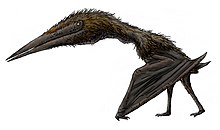
Aegirocassis[edit]

A drawing of Aegirocassis, purged after reviewing it [14]. Any comment. --Levi bernardo (talk) 18:00, 30 March 2015 (UTC)
- Looks good clean, but I know little about invertebrates... FunkMonk (talk) 11:00, 16 April 2015 (UTC)
- Thank you. I am learning a little about them --Levi bernardo (talk) 20:43, 24 April 2015 (UTC)

Based on the skulls from "European Paleolithic Dogs" and "Prehistoric Dog Found with Mammoth Bone in Mouth", also the description from "Palaeolithic dog skulls at the Gravettian Předmostí site, the Czech Republic". Editor abcdef (talk) 05:18, 26 April 2015 (UTC)
- Well, the general anatomy seems quite a bit rough. I'd suggest studying stuff like this.[15] FunkMonk (talk) 09:45, 26 April 2015 (UTC)
Goyet Cave canid full skull[edit]

Based on the skull image from the archaeology website. Editor abcdef (talk) 11:25, 26 April 2015 (UTC)
- Why is it grey between the teeth? FunkMonk (talk) 15:16, 14 May 2015 (UTC)
- Fixed. Editor abcdef (talk) 00:05, 15 May 2015 (UTC)

This is my reconstruction of the very complete terror bird LLallawavis... what do you think? [16] --Rextron (talk) 20:26, 16 May 2015 (UTC)
- Looks good, though I'm not sure what's going on with the leg on the ground compared to the skeletal?[17] In the skeletal, the outer toe seems to be free of the ground, and the hallux points down, but these two seem somehow to be combined in your drawing? FunkMonk (talk) 21:00, 16 May 2015 (UTC)
- Oops, you're right about the toes. I'll correct them.--Rextron (talk) 09:31, 17 May 2015 (UTC)
- Not sure if it is just hidden by feathers in your drawing, but it seems the skull has a very distinct "dent" between the beak and the head? FunkMonk (talk) 10:52, 18 May 2015 (UTC)
- I'm not sure what you mean... the division between the skin and the beak in the lower part of the skull?--Rextron (talk) 02:12, 20 May 2015 (UTC)
- I mean the upper beak, the profile is very convex, it is emphasised in this restoration: http://cdn4.sci-news.com/images/enlarge/image_2684_1e-Llallawavis-scagliai.jpg FunkMonk (talk) 02:20, 20 May 2015 (UTC)
- I'm not sure what you mean... the division between the skin and the beak in the lower part of the skull?--Rextron (talk) 02:12, 20 May 2015 (UTC)
- Not sure if it is just hidden by feathers in your drawing, but it seems the skull has a very distinct "dent" between the beak and the head? FunkMonk (talk) 10:52, 18 May 2015 (UTC)
- Oops, you're right about the toes. I'll correct them.--Rextron (talk) 09:31, 17 May 2015 (UTC)
- Ok, sorry for the delay. So, certainly the feathers hides the profile of the beak, I modified it to show better the shape: [18] also, I put the palate and the modified position of the toes (emphasizing the "killer claws" also found in the seriemas). [19] --Rextron (talk) 06:51, 22 May 2015 (UTC)
- Alright! But do we know if any other cariamoids, or what they're called, had such toes? FunkMonk (talk) 12:38, 22 May 2015 (UTC)
- Well, the enlarged second toe (with a long horn covering) is a feature of modern seriemas: [20] and is found too in different genus of terror birds, so although the toes are not preserved in Llallawavis, it must share this condition. Actually, there is a thesis (Jones, 2010) entirey devoted to the second toe of phorusrhacids, and except for the abstract, is in Spanish [21] I translate here one of the conclusions: "The long and curved claws that they (the phorusrhacids) shares with the modern cariamids suggests some kind of anatomical mechanism that allows to these big cursorial birds bear the claws (of the second toe) raised and avoid the wearing by abrasion or even fracture" (p. 123; parenthesis are mine). --Rextron (talk) 19:28, 22 May 2015 (UTC)
- Alright! But do we know if any other cariamoids, or what they're called, had such toes? FunkMonk (talk) 12:38, 22 May 2015 (UTC)
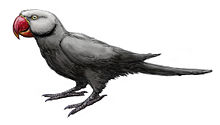
Here's a restoration of the recently extinct parrot Psittacula bensoni. Other restorations can be seen here[22], but they vary quite a bit. This drawing is based on how Julian Hume interprets old accounts an fossils in a 2007 article, and on proportions and features of the extant relative Psittacula eupatria. FunkMonk (talk) 02:48, 21 May 2015 (UTC)
- It looks great --Levi bernardo (talk) 15:01, 21 May 2015 (UTC)

Well, here is a reconstruction of the skull of this recently named astrapothere: [23] This is based in the illustrations of the original paper, but also based in personal observations and the comparison with Astrapotherium. --Rextron (talk) 09:51, 7 June 2015 (UTC)
- What would personal observations be? FunkMonk (talk) 09:55, 7 June 2015 (UTC)
- Well, in the photos released in the paper you only can see the skull seen from the underside (palatal view), but I have seen the actual skull in a museum, so I could make a sketch of the lateral view (including the remain of the orbits of the skull).--Rextron (talk) 10:20, 8 June 2015 (UTC)
- Ok. By the way, have you considered uploading museum photos? FunkMonk (talk) 12:29, 8 June 2015 (UTC)
- Unfortunately, I don't have a camera, just a really crappy cellphone photos, or trust me, I will upload the photos of this and another animals from Colombia. On another hand, there is another issue with the image, before upload it?--Rextron (talk) 06:11, 9 June 2015 (UTC)
- Nah, hard to say when the ref isn't online, my only observation would be that it seems more common to show such restorations on white background, with known parts in white, and the rest in grey, but that's up to the individual artist. FunkMonk (talk) 06:14, 9 June 2015 (UTC)
- Unfortunately, I don't have a camera, just a really crappy cellphone photos, or trust me, I will upload the photos of this and another animals from Colombia. On another hand, there is another issue with the image, before upload it?--Rextron (talk) 06:11, 9 June 2015 (UTC)
- Ok. By the way, have you considered uploading museum photos? FunkMonk (talk) 12:29, 8 June 2015 (UTC)
- Well, if is still useful, you can compare it with the photos of the article: [24] and [25] --Rextron (talk) 08:50, 12 June 2015 (UTC)
- Well, in the photos released in the paper you only can see the skull seen from the underside (palatal view), but I have seen the actual skull in a museum, so I could make a sketch of the lateral view (including the remain of the orbits of the skull).--Rextron (talk) 10:20, 8 June 2015 (UTC)

Hi everyone! Here is a restoration of the madeiran scops owl (Otus mauli). Mainly based on the illustrations from the article (1) and images from the eurasian scops owl. Any comments? --El fosilmaníaco (talk) 20:34, 12 June 2015 (UTC)
- Looks good, the beak seems a bit crooked towards one side though? Also, be sure to mention in the file description and captions that the image is hypothetical... Bird editors are a bit more critical when they see selfmade restorations. FunkMonk (talk) 21:17, 12 June 2015 (UTC)
- Well, I've tried to rotate the beak a bit, although I'm not very trained on editing images and the result may look a bit odd. Maybe with a smaller version of the image this would look better...--El fosilmaníaco (talk) 14:11, 13 June 2015 (UTC)
- Looks better to me at least. If you don't have a proper image editing programme, Gimp is free and pretty good: http://www.gimp.org/ FunkMonk (talk) 06:01, 14 June 2015 (UTC)
- Oh, yes, I do have GIMP, you recommended it to me a couple of years ago. Anyway, thanks for your advice!--El fosilmaníaco (talk) 13:26, 14 June 2015 (UTC)
- Looks better to me at least. If you don't have a proper image editing programme, Gimp is free and pretty good: http://www.gimp.org/ FunkMonk (talk) 06:01, 14 June 2015 (UTC)
- Well, I've tried to rotate the beak a bit, although I'm not very trained on editing images and the result may look a bit odd. Maybe with a smaller version of the image this would look better...--El fosilmaníaco (talk) 14:11, 13 June 2015 (UTC)
Imagery[edit]
In the last month I've been updating my old pictures and making some new versions, comments. --Levi bernardo (talk) 00:26, 15 June 2015 (UTC)
- Looks good, a few comments. Bavarisaurus: I don't think it is natural for a lizard to hold its tial straight into the air like that. The feet also look very short and lumpy, skeletal restoration:[26] Eurotamandua: The neck, lower jaw, tail, arms, legs and feet look too short, and the claws too short and straight, compared to this skeletal:[27] I would also expect the teeth of Cryptovenator being sharper in life. FunkMonk (talk) 04:56, 15 June 2015 (UTC)
- Hello, sharpen teeth Cryptovenator, and here's a new WIP version of Bavarisaurus [28]. --Levi bernardo (talk) 14:10, 11 July 2015 (UTC)
Forstercooperia (2)[edit]

I made a new version of the head of this animal [29], since that the previous image seems have some issues with the lips, ears and eyes. I originally planned just change the previous image, but I ended making a new version, based in another species, F. totadentata (from this skull: [30]) What do you think? --Rextron (talk) 09:34, 20 June 2015 (UTC)
- Looks good, it is also a different species than the one Reid did, it seems. FunkMonk (talk) 16:39, 20 June 2015 (UTC)
Images by User:Foolp[edit]
These are the non-dinosaurian images by foolp, his other work being reviewed at the dinosaur review.IJReid discuss 14:49, 25 July 2015 (UTC)
-
Ediacaran fauna
- Illustration of Ediacaran fauna is perfect, but the illustration of Leptictidium seems the tail starts well but ends very thick. --Levi bernardo (talk) 14:26, 26 July 2015 (UTC)
- Sadly, I don't know how correct the tail of Lepticidium. I drew a cambrian scene with Anomalocaris.--Foolp (talk) 15:59, 26 July 2015 (UTC)
- For lepticidium, maybe just make the tail gradually thinner towards the end. The anomalocaris looks good, but someone else might have comments before it is added to the article. IJReid discuss 21:16, 26 July 2015 (UTC)
- So, the tail of Lepticidium is corrected. Are there problems with Anomalocaris ? I don't know a lot about arthropods--Foolp (talk) 11:01, 27 July 2015 (UTC)
- Leptictidium is good. I have experience with invertebrates. and I can say that his Anomalocaris is very good, but the lateral lobes were more curved, and is missing three lobes. And the tail lobes were so [34] [35]. --Levi bernardo (talk) 14:02, 27 July 2015 (UTC)
- Thanks Levi but I think that correct Anomalocaris and adds lobes will take time Foolp (talk) 10:17, 28 July 2015 (UTC)
- Leptictidium is good. I have experience with invertebrates. and I can say that his Anomalocaris is very good, but the lateral lobes were more curved, and is missing three lobes. And the tail lobes were so [34] [35]. --Levi bernardo (talk) 14:02, 27 July 2015 (UTC)
- So, the tail of Lepticidium is corrected. Are there problems with Anomalocaris ? I don't know a lot about arthropods--Foolp (talk) 11:01, 27 July 2015 (UTC)
- For lepticidium, maybe just make the tail gradually thinner towards the end. The anomalocaris looks good, but someone else might have comments before it is added to the article. IJReid discuss 21:16, 26 July 2015 (UTC)
- Sadly, I don't know how correct the tail of Lepticidium. I drew a cambrian scene with Anomalocaris.--Foolp (talk) 15:59, 26 July 2015 (UTC)
- Seems the Bunostegos needs upright legs: http://phenomena.nationalgeographic.com/2015/09/21/reptile-relative-was-among-the-first-animals-to-walk-on-upright-legs/ FunkMonk (talk) 10:38, 22 September 2015 (UTC)
- Actually databases about anatomy of pareiasaurs are often quite contradictory. I had to make choices for this reconstitution--Foolp (talk) 15:20, 7 October 2015 (UTC)
- But the recent data indicates that specifically Bunostegos walks upright. So, the image needs a revision, or even a completely new version.--Rextron (talk) 04:28, 8 October 2015 (UTC)
- Yes you're right, after some searchs I found this too (there is a big lag beetween french and american databases^^). I don't think I can correct (skull looks wrong too) this draw so I'll do a new one. Maybe it's better to delete the ancient and false reconstitution ?--Foolp (talk) 16:28, 8 October 2015 (UTC)
- But the recent data indicates that specifically Bunostegos walks upright. So, the image needs a revision, or even a completely new version.--Rextron (talk) 04:28, 8 October 2015 (UTC)
- Actually databases about anatomy of pareiasaurs are often quite contradictory. I had to make choices for this reconstitution--Foolp (talk) 15:20, 7 October 2015 (UTC)
- And seems the skull and neck of Quetzalcoatlus are too small and short?[36] FunkMonk (talk) 14:04, 7 October 2015 (UTC)
Hallucigenia Sparsa[edit]

So I made the old, recently removed reconstruction of Hallucigenia...in the intervening years since that was made both my art skills and science's data about hallucigenia have progressed considerably, so I though I'd throw together a 2.0 to replace my old scribblings. I think I got all the legs and tentacles in there, but lemme know if I missed anything. Still trying to decide if it needs to have the contrast or brightness bumped up, so input on that part welcomed as well- I've been looking at it too long to say for sure tonight. Primary references were the excellent diagrams found in this Nature article. As a side note, it makes me happy to no end that this lovecraftian critter actually existed. ^_^ --Scorpion451 rant 02:22, 27 November 2015 (UTC)
- Seems the claws look a bit more like hooves? Compare with the "official" new reconstruction:[37] Also, it appears to have a wrinkled texture, where the other one is smooth, and the neck doesn't seem to taper behind the head. But I know little about these creatures, nice style! FunkMonk (talk) 17:30, 27 November 2015 (UTC)
- Yep- thats actually from that article I linked to (which should be slightly easier to look at now that I fixed the link.) Went with a slightly different take on it from their artist after looking at hallucigenia's suspected closest living relatives, like velvet worms, Priapulid worms, Kinorhynchans, and tardigrades . They all seem to have that same sort of wrinkly annular ridging, so I figured it followed that hallucigenia could have had the same sort of thing going on. I'll tinker more with the claws- the hoof arrangement made more sense to me than having them just flopping around, but looking at this from the velvet worms and the tardigrades, both I and the article's artist might have them wrong; they might be parallel like a cat claw. (would be really nice if we could get an expert in on this part)











